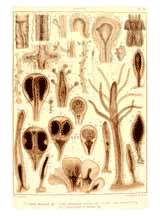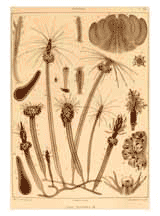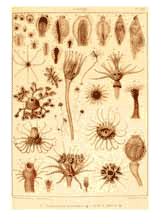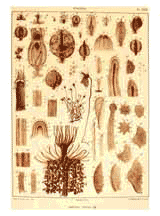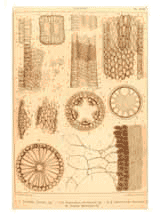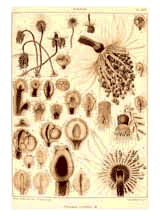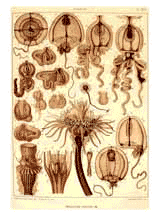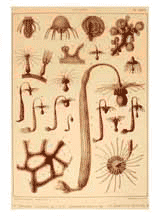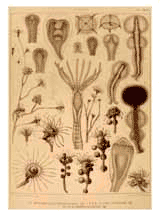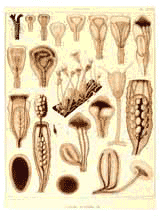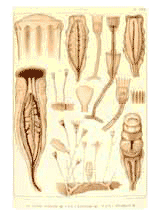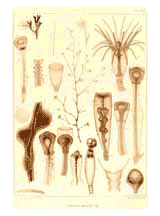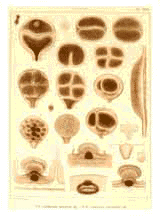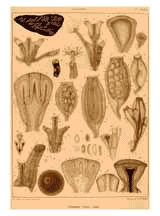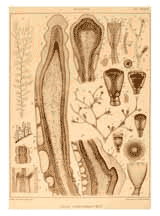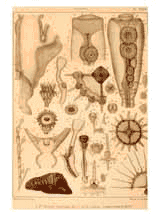


CONTRIBUTIONS
to
THE NATURAL HISTORY
of the
UNITED STATES OF AMERICA
by
LOUIS AGASSIZ
Second Monograph
In Five Parts. - I.
Acalephs in General. - II. Ctenophorae. - III. Discophorae. - IV.
Hydroidae. - V. Homologies of the Radiata.
With Forty-Six Plates
Volume IV
BOSTON:
LITTLE, BROWN AND COMPANY.
LONDON:
TRÜBNER & CO.
1862.
380 + 18 pages with 18 plates and 50 woodcuts.
This electronic edition prepared by Dr. David C. Bossard
from original documents in the library holdings of
Dartmouth College, Hanover New Hampshire.
December, 2005.
Copyright © 2005 by David C. Bossard.
NOTE: If the woodcut legends are too small to read easily, you may view
high resolution (400ppi) images at text-figures.
These images are listed by page number and figure number.
VOLUME IV
CONTENTS.
PART
III.
DISCOPHORAE
CHAPTER I.
DISCOPHORAE IN GENERAL
SECTION 1. Structure of the Discophorae. 003
004
005
006
Natural Limits of the order.
Discophorae phanerocarpae Esch.,
Steganophthalmata Forbes,
Aeraspeda Gegenb. p. 3-6.
SECTION 2. Sub-orders of the discophorae proper. 007
008
009
Their limitation. How families differ
from sub-orders. Rhizostomeae, Semoeastomeae, Haplostomeae. p. 7-9.
CHAPTER II.
THE GENUS AURELIA AND ITS
SPECIES.
SECTION 1. General remarks. 010
011
012
Different modes of study and
sub-divisions of our science. p. 10-12.
SECTION 2. Formation and growth of Aurelia flavidula, including
comparisons with Cyanea aretica. 012
013
014
015 016
017
018
019 020
021
022
023
024
025
026
027 028
029
030
031
032
033
034
035
036
037
038
039
040
041
042
043
044
045
046
047
048
049
050
051
The egg of Aurelia flavidula. The
planula of Aurelia flavidula. The egg of Cyanea aretica. The planula of
Cyanea artica. The scyphostoma of Aurelia and Cyanea. Histology of the
scyphostoma. The strobila of Aurelia. The ephyra of Aurelia. Structure
of the eye, by Prof. H.J. Clark. The lasso-cells and their special
structure. p. 12-51.
SECTION 3. Structure of the adult Aurelia flavidula. 051
052
053
054
055
056
057
058
059
060
061
062
063
Symmetry of the body. Primary number of
identical segments. Ambulaeral and interambulaeral systems. The young
and the adult. Compared to Echinoderms. p. 51-63.
SECTION 4. Homological relations of Aurelia and Echinoderms.
063
064
065
066
067
068 069
070
071
072
The Coelenterata and Echinodermata
built upon the same plan. Arrangement of their spheromeres. Comparision
of Aurelia with Echinarachnius. The radiating tubes of the Acalephs and
Echinoderms. p. 63-72.
SECTION 5. Closer affinities of Aurelia. 072
073 074
075
Resemblance between the younbg and the
Aeginidae, while the adult approximates the Rhizostomeae. p. 72-75.
SECTION 6. Habits of Aurelia. 075
076
077
078
Its appearance in the spring and
disappearance in the autumn; passes the winter in a larval condition.
p. 75-78.
SECTION 7. Nomenclature of Aurelia. 078
079
The young and the adult, in various
states of preservation, referred to many genera, supposed to be
distinct, but all of which must now be suppressed. p. 78-79.
SECTION 8. Peculiarities of the Aurelidae as a family. 080
Its special pattern. p. 80.
SECTION 9. Generic characters of Aurelia, and specific characters
of the Aurelia flavidula of North America. 081
082 083
084
085
086
Comparison with the European Aurelia
nurita. Enumeration of the species of this genus. p. 81-86.
CHAPTER III.
THE GENUS CYANEA AND ALLIED
GENERA.
SECTION 1. General description of Cyanea artica. 087
088
089
090
Difficulties in describing Acalephs.
Misuse of names to designate their parts. p. 87-90.
SECTION 2. The abactinal system of Cyanea. 091
092
093
094 095
Imperfection of older illustrations.
Structure and appearances. p. 91-95.
SECTION 3. The lower floor of Cyanea, and its connection with the
upper floor. 095
096
097
098
099
100
101
102
103
104
105
106
107
108
Actinal system. Homology of the parts.
Essential elements of the structure of Cyanea. Large amount of
structural water in Acalephs. Broad and narrow pouches alternating.
Concentric and radiating folds. Tentacles. Genital pouches..Complicated
structure of the actinostome. Effects of sections upon living Medusae.
p. 95-108.
SECTION 4. Growth of Cyanea. 109
110
111
112
The young compared to adults of
different species. p. 109-112.
SECTION 5. Histology of Cyanea. 112
113
114
The actinostome and the tentacles. p.
112-114.
SECTION 6. Cyaneidae as a family. 114
115
Their form exhibits a peculiar pattern.
p. 114-115.
SECTION 7. The genus Cyanea compared with other genera. 115 116
117
118
119
Phacellophora and Heccaedeconima.
Sthenonia. Stenopytycha. Chrysaora. Couthonyia. Medora. Patera.
Donacostoma. Pelagia. p. 115-119.
SECTION 8. The Species of Cyanea compared with one another. 119 120
Cyanea arctica, fulva and versicolor.
Cyanea capillata and Lamarckii. Cyanea Postelsii and ferruginea. p.
119-120.
CHAPTER IV.
THE GENUS PELAGIA AND
ALLIED GENERA.
SECTION 1. The family of Pelagidae. 121
122
123
124
Its characters. Nausithoe probably the
young of Pelagia. p. 121-124.
SECTION 2. The genera of Pelagidae. 124
125
126
127
Pelagia. Placois. Chrysaora.
Dactylometra. Polybostrycha. Melanaster. Zygonema. p. 124-127.
SECTION 1. Description of Pelagia cyanella. 128
129
130
Direct development from the egg: the
embryo assumes the form of an ephyra, without ever passing through the
strobila state characteristic of aurelia. Comparison of the young with
Nausithoe. p. 128-130.
CHAPTER V.
THE DISCOPHORAE RHIZOSTOMEAE
SECTION 1. The Rhizostomeae in general. 131
132
133
134
135
136
137
Structural peculiarities. Polystomy.
Constitute a distinct sub-order, with many families. p. 131-137.
SECTION 2. The genus Stomolophus. 138
Comparison with Rhizostoma. p. 138.
SECTION 3. The genus Polyclonia. 139
140
141
142
143
144
145
146
147
148
Founded upon Medusa frondosa Pall.,
recently obsered in Florida. Its peculiar habits; gropes in the mud,
and is seldom seen floating in the water. Polyclonidae as a family.
Generic characters. p. 139-148.
CHAPTER VI.
ENUMERATION AND
GEOGRAPHICAL DISTRIBUTION OF THE DISCOPHORAE
SECTION 1. Tabular view of the discophora known at present. 149
150
151
152
153
154
155
156
157
158
159
160
161
162
163
164
165
166
167
168 169
170
171
172
173 174
175
176
They form three sub-orders, with
fifteen families. p. 149-176.
SECTION 2. Geographical distribution of the Discophorae. 177
178
179
180
The lower types are the most widely
distributed. Distinct Acalephian Faunae. p. 177-180.
PART IV. - HYDROIDAE
CHAPTER I.
CORYNE AND ALLIED MEDUSAE
SECTION 1. General remarks upon the Hydroids and naked-eyed
Medusae. 183
184
185
Hydra and Medusa Form.
Bibliography. p., 183-185.
SECTION 2. The Hydroid form of Coryne mirabilis. 185
186
187
188
189
190
The hydrarium and its structure.
p. 185-190.
SECTION 3. The reproduction of coryne mirabilis. 190
191
192
193
194 195
196
197
198
199
200
201
202
203
204
The budding of Hydroids and Medusae. p.
190-204.
SECTION 4. Histology of Coryne mirabilis. 204
205
206
207
208
209
210
211
The adult Hydroid. The Medusae-buds.
The structure of the egg. p. 204-211.
SECTION 5. Adult Medusa of Coryne (Sarsia) mirabilis. 212
213
214
215 216
217
Its form varying extensively, its
habits and voracious dispositions, its quick motions, its structure.
Anomaly in the number of spheromeres and bearing of these variations
upon specific distinctions. Family affinities of the Hydroids and
Medusae. The Hydroids of the same family bear similar relations to one
another as the free Medusa. p. 211-217.
CHAPTER II.
THE GENERA CLAVA AND
RHIZOGETON
SECTION 1. The adult Hydroid of Clava leptostyla. 218
219 220
Bibliography. Structure. p. 218-220.
SECTION 2. The medusoid buds of Clava leptostyla. 221
222
They are the simplest among the
Tubularians, and never appear as independent Medusae. p. 221-222.
SECTION 3. Embryology of Clava leptostyla. 222
223
224
It produces planulae. p. 222-224.
SECTION 4. Rhizogeton fusiformis. 224
225
226
The adult hydromedusarium. The
Hydroids. The Medusae-buds. Transformation of the Medusae-buds into
Hydroids. p. 224-226.
CHAPTER III.
THE GENERA HYDRACTINIA AND
HALOCHARIS
SECTION 1. The hydroid form of Hydractinia polyclina. 227 228
229
230
231
232
233
234
235
Bibliography. Polymorphism. The fretile
Hydroid. The sterile Hydroid. p. 227-235.
SECTION 2. Reproduction of Hydractinia polyclina. 235
236
The Hydroid. The Medusoid. p. 235-236.
SECTION 3. Histology of Hydractinia. 236
237
238
239
The Hydroid, the lasso-cells. The horny
basis. The egg. The spermatic particles. p. 236-239.
SECTION 4. Halocharis spiralis. 239
240
Proles hydroidea. Histology. p. 239-240.
CHAPTER IV.
THE FAMILY OF TUBULARIDAE
SECTION 1. General remarks upon the Tubularians. 241
242
243
Bibliography. The family of Tubularidae
circumscribed within its natural limits. p. 241-243.
SECTION 2. Hyboeodon prolifer. 243
244
245
246
247
248
249
Adult hydroid. Proles medusoidea.
Embryology. Histology. p. 243-249.
-- Since this chapter was printed, I have ascertained that Euphysa
belongs to the cycle of Hoboeodon; but it remains to be seen whether
the Medusa, here described as Hybocodon, is transformed into a genuine
Euphysa, or the Euphysa produced from the tentacular buds of a
Hyboeodon.
SECTION 3. Parypha crocea. 249
250
251
252
253
254
255
256
257
258
259
260
261
262
263
264
265
Adult Hydroid and adult Medusoid.
Embryology. development of the hydra. Germ-basis.. Medusae-buds.
Histology. p. 249-265.
SECTION 4. Tubularia Canthanyi. 266
267
268 269
270
271
Adult Hydroid. Full-grown Medusoid.
Embryology. Histology. p. 266-271.
SECTION 5. Thaumocnidia spectabilis. 271
272
273 274
275
276
Adult Hydroid. Full-grown Medusoid.
Embryology. Thammocnidia tenella. p. 271-276.
SECTION 6. Corymorpha pendula. 276
277
278
The Hydroid. The Medusae-buds. p.
276-278,
CHAPTER V.
THE GENUS EUDENDRIUM OF
EHRENBERG.
SECTION 1. Remarks on the Hydroids referred to the genus Eudendrium,
and ther free Medusae. 282 283
284
285
Bibliography. The Hydroids of this type
belong to three different families. p. 282-285.
SECTION 2. Eudendrium dispar. 285
286
287
288
289
The Hydroid and the Medusoid. p.
285-289.
SECTION 3. Bougaincillia superciliaris. 289
290
291
The Hydroid, the Medusae-bud, and the
free Medusa. p. 289-291.
CHAPTER VI.
THE DORALLARIA TABULATA AS
HYDROIDS.
SECTION 1. Millepora alcicornis. 292
293
294 295
Its Hydra. There are twokinds of them,
large and small ones. They have no special affinity to the class of
Polyps. The Coral stock. p. 292-295.
SECTION 2. Pocillopora damicornis. 295
296
The Coral-stock has the same structure
as Millepora. p. 295-296.
SECTION 3. Scriatopora subulata. 296
Affinities to the Corallaria Rugosa. p.
296.
CHAPTER VII.
THE GENERA OF THE
CAMPANULARIANS.
SECTION 1. Clytia (Orthopyxis) poterium. 297
298
299
300
301
302
303
304
Bibliography. Adult Hydroid.
Embryology. p. 297-304.
SECTION 2. Clytia (Trochopyxis) bicophora. 304
305
306
Adult Hydroid. Embryology. p. 304-306.
SECTION 3. Clytia (Platypyxis) cylindrica. 306
307
308
Free Medusa. Hydroid. The
Campanularians embrace Acalephs of different families. p. 306-308.
SECTION 4. Tiaropsis diademata. 308
309
310
311
Free Medusa. Embryology. Order of
succession of the tentacles p. 308-311.
SECTION 5. Laomedea amphora. 311
312
313
314
315
Adult Hydroid, No free Medusa.
Embryology. p. 311-315
SECTION 6. Obelia commissuralis. 315
316
317
318
319 320
321
Péron's genus Obelia. Adult
Hydroid. Embryology. Free Medusa. p. 315-321.
SECTION 7. Eucope diaphana. 322
323
324
325
Adult Hydroid and its affinities.
Embryology. Free Medusa. p. 322-325.
SECTION Dynamena pumila. 326
327 328
329
330
331
332
Bibliography. Structure of the adult
Hydroid. Adult Medusoid. Embryology. Budding. p. 326-332.
CHAPTER VIII.
THE GENUS EUDENDRIUM OF
EHRENBERG.
SECTION 1. Siphonophorae in general. 333
334
335
Ought to be subdivided into separate
sub-orders. p. 333-335.
SECTION 2. The genus Physalia. 335
336
Its polymorphism and special
characters. p. 335-336.
CHAPTER IX.
CLASSIFICATION OF THE
HYDROIDAE.
SECTION 1. Tabular view of the whole order of Hydroidae. 337
338
339
340
341
342
343
344
345
346
347
348
349
350
351
352
353
354
355
356
357
358
359
360
361
362
363
364
365
366
367
368 369
370
371
It embraces eight sub-orders, with
forty-six families. p. 337-371.
SECTION 2. Geographical distribution of the Hydroidae. 371
Location of these Acalephs. p. 371.
PART V. - HOMOLOGIES OF THE RADIATA.
SECTION 1. General Homologies. 375
376
Normal position and natural attitudes
to be distinguished. Plan of structure. Spheromeres. p. 375-376.
SECTION 2. Special Homologies of the Classes. 377
378
379
380
Correspondence between the structure of
Polyps and that of the Acalephs and Echinoderms. p. 377-380.
Plate
Descriptions 381-392 381
382 383
384
385
386
387
388
389
390
391
392
PLATES



